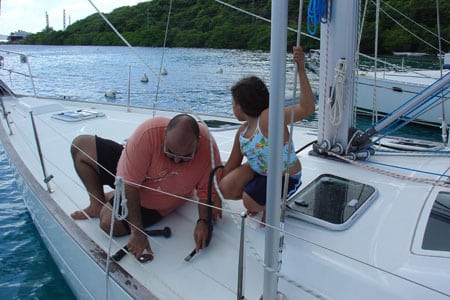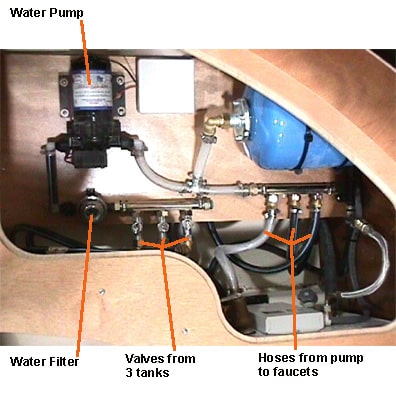Plumbing and Tankage – Getting Familiar with a Charter Boat
A diaphragm pump below directs flow from the water tank(s) to various faucets throughout the boat. You’ll always begin a charter with full water tanks but understand that water conservation is still required. Locate the deck fill fittings leading to the tanks, and fill until water flows onto the deck. Air should leave through vents located near the fill fittings. Observe the bilge area while filling; leaks will cause clear water to stream into the bilges.
|
Anecdote
If your crew is filling the water tanks – just quietly double-check to ensure they are filling the correct tanks. One time we observed someone begin to fill the waste tank port. And worse yet – the waste tank was disconnected and the drain was into the bilge. The boat had 5 inches of water in the bottom before the error was discovered. The crew member did wonder why it was taking so long to fill the tank. |
Most boats have at least two tanks. And at some point during the charter, you’ll run the first tank dry. So you’ll need to know the location of the valves which allow you to begin draining from the second tank. Typically all that is needed is that you shut off the tank that is empty and open the valve leading to the new tank. The pump will prime itself and after spitting air and water out the faucet for a little while then even water flow will start again. It’s also important for you to ensure your crew knows this location and procedure as well. Invariably the tank will run dry on someone all soaped up while you’re running around town getting croissants for breakfast.
A circuit breaker on the electrical panel activates the water pump. It should pump briefly to build pressure and then shut off. It pumps again when a faucet opens, and should shut off a few seconds after the faucet closes.
If the pump activates without water flowing, the tank could be empty, air could be in the water line or pump, the freshwater filter may be obstructed, or a hose or faucet leak is indicated.
- Observe the filter, pump, and all valves and connections in the vicinity first. This is the most likely spot to diagnose trouble. Repairs can involve tightening hose clamps, cleaning the filter, and replacing hoses, fittings, or valves.
- open the inspection port of each water tank, looking for water, a broken or loose fitting or obstructions in the egress line.
- Inspect the pump itself; most leaks are there.
- If not any of the above, switch the water tank valves between tanks, attempting to isolate the leaking lines. This can take time and be frustrating, but should eventually reveal what line(s) leak.
- In some cases, the water pump itself is the problem. You can typically leave this problem to the charter company but if you need to then remove the pump, and open the plate revealing the diaphragm and internal valves. Remove any obstructions or replace a damaged diaphragm.
- Air may also have infiltrated a water line. If so, the pump will not operate without being primed. Either re-fill the tank to force water into the pump while air is expelled from a faucet, or switch tanks while running the pump to expel air.








